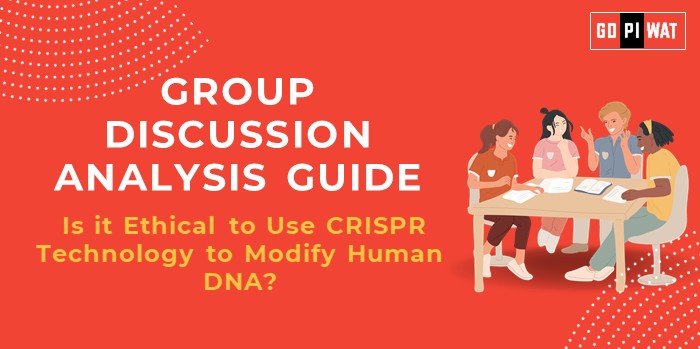📋 Group Discussion (GD) Analysis Guide: Is it Ethical to Use CRISPR Technology to Modify Human DNA?
🌐 Introduction
- Opening Context: CRISPR-Cas9 technology has revolutionized genetic engineering, offering precise DNA modification to address complex challenges in medicine and biotechnology. However, the ethical dimensions of human DNA editing remain a global debate.
- Topic Background: CRISPR technology allows genetic modifications with unprecedented precision. The birth of the first gene-edited babies in 2018 sparked global discussions on the ethical boundaries of such innovations.
📊 Quick Facts & Key Statistics
- First CRISPR Babies (2018): Chinese scientist He Jiankui engineered twins Lulu and Nana to resist HIV, leading to global condemnation and his imprisonment for ethical violations.
- Genetic Disease Prevalence: Approximately 7.9 million children are born annually with serious genetic defects, underlining CRISPR’s potential in medical advancements.
- Market Growth: The global CRISPR market reached USD 3.78 billion in 2024 and is projected to grow at a CAGR of 19.89%, hitting USD 9.34 billion by 2029.
- Regulatory Landscape: While some countries impose strict guidelines or moratoriums on germline editing, others are developing frameworks to oversee therapeutic applications.
👥 Stakeholders and Their Roles
- Scientists and Researchers: Innovating and testing applications while addressing ethical concerns.
- Governments and Regulators: Crafting laws to ensure CRISPR’s responsible use.
- Healthcare Providers: Exploring CRISPR’s role in treating genetic diseases.
- Ethics Committees and NGOs: Advocating for equity, safety, and moral considerations.
✅ Achievements and Challenges
- Achievements:
- Eradicating Diseases: Promising trials in addressing Huntington’s disease and HIV resistance.
- Agricultural Innovation: Enhanced crop yields and pest resistance.
- Therapeutic Success: Effective treatments for blood disorders like beta-thalassemia.
- Challenges:
- Ethical Dilemmas: Risk of misuse for non-therapeutic purposes, like designer babies.
- Off-Target Effects: Potential unintended genetic modifications.
- Regulatory and Social Gaps: Varied approaches to regulation across countries.
🌍 Global Comparisons
- USA: Regulatory stringency limits germline editing but promotes therapeutic research.
- China: Rapid advancements but criticized for ethical lapses.
📖 Case Studies
- He Jiankui Experiment: Raised awareness of the urgent need for global regulations.
🔍 Effective Discussion Approaches
- Opening Approaches:
- “With 7.9 million children born annually with genetic defects, CRISPR’s promise to eliminate such conditions is undeniable.”
- “Does curing genetic diseases justify experimenting on human embryos?”
- Counter-Argument Handling:
- Acknowledge misuse concerns but emphasize regulation and oversight as safeguards.
🛠️ Strategic Analysis of Strengths & Weaknesses
- Strengths: Precision in gene editing, medical breakthroughs, agricultural innovations.
- Weaknesses: Ethical risks, potential off-target effects, high costs.
- Opportunities: Eradicating genetic diseases, advancing personalized medicine.
- Threats: Unequal access, potential misuse, unknown long-term consequences.
💬 Structured Arguments for Discussion
- Supporting Stance: “CRISPR has the potential to eliminate genetic diseases, improving the quality of life for millions.”
- Opposing Stance: “The risk of misuse, such as creating ‘designer babies,’ could exacerbate societal inequities.”
- Balanced Perspective: “While CRISPR’s benefits are undeniable, robust ethical guidelines are crucial for its responsible application.”
📚 Connecting with B-School Applications
- Real-World Applications: Insights into healthcare policy, biotech entrepreneurship, and ethical leadership.
- Sample Questions:
- “What are the implications of CRISPR for global healthcare access?”
- “How would you balance innovation with ethical considerations?”
- Insights for Students:
- Explore CRISPR’s role in biotech startups and sustainable healthcare models.
- Investigate ethical frameworks governing disruptive technologies.


